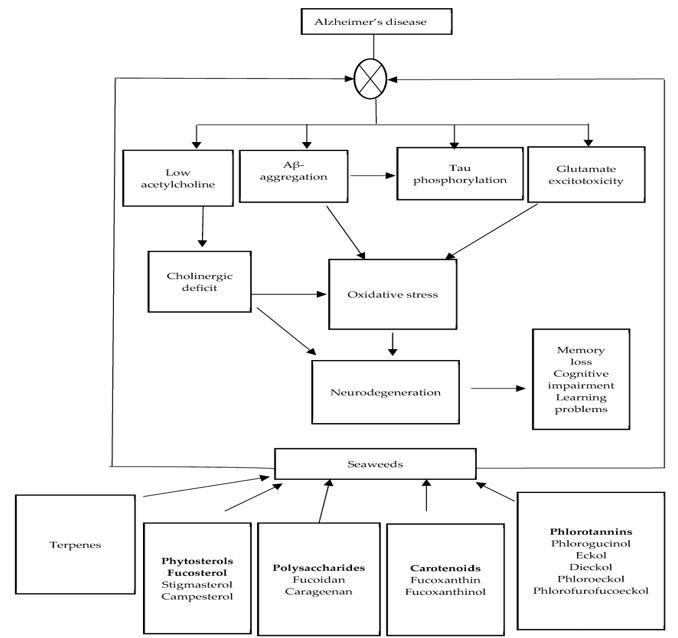Marine Drugs as a Valuable Source of Natural Biomarkers Used in the Treatment of Alzheimer’s Disease by UMA NATH U* in Open Access Journal of Biogeneric Science and Research
ABSTRACT
Alzheimer’s disease (AD) is a multifactorial neurodegenerative disorder. Current approved drugs may only ameliorate symptoms in a restricted number of patients and for a restricted period of time. Currently, there is a translational research challenge into identifying the new effective drugs and their respective new therapeutic targets in AD and other neurodegenerative disorders. In this review, selected examples of marine-derived compounds in neuro degeneration, specifically in AD field are reported. The emphasis has been done on compounds and their possible relevant biological activities. The proposed drug development paradigm and current hypotheses should be accurately investigated in the future of AD therapy directions.
KEYWORDS: Marine drugs; Alzheimer’s disease; Mechanisms of activity
Introduction
Right now, 46.8 million persons in the world are suffering from dementia and it is expected that this number will increase to 74.7 million in 2030 and 131.5 million in 2050. Alzheimer’s disease (AD) is the main cause of dementia in the elderly. AD is a progressive, continuous and incurable brain disorder leading to increase severe disability such as memory loss (amnesia), minimal to no communication (aphasia), the inability to perform activitiesofdaily living (ADL) (apraxia), the impairment of the sensory input (development of agnosias). In briefly, AD is a multifactorial neurodegenerative disorder that affects cognition (memory, thinking, and language abilities), quality of life and self-sufficiency in elderly [2]. AD is strictly related to aging, indeed the majority of cases (≥ 90%) are initially diagnosed among persons ≥ 65 years of age (AD with late onset-LOAD). In particular, genes involved in the production of the amyloid β (Aβ) peptides such as amyloid precursor protein (APP), Presenilin 1 (PSEN1), and 2 (PSEN2) may account for as much as 5%–10% of the EOAD incidence.
BRYOSTATIN
Bryostatin 1 is a natural product derived from the marine invertebrate Bugula neritina. It has potent and broad antitumor activity. Bryostatin 1 activates protein kinase C family members, with nanomolar potency for PKC1α and ε isotypes.
In the central nervous system, bryostatin 1 activation of PKC boosts synthesis and secretion of the neurotrophic factor BDNF, a synaptic growth factor linked to learning and memory. The compound also activates nonamyloidogenic, α-secretase processing of amyloid precursor protein.
Preclinical work on bryostatin in nervous system diseases has mainly come from the Alkon lab. In their studies, intraperitoneal administration activated brain PKCε and prevented synaptic loss, Aβ accumulation, and memory decline in Alzheimer’s disease transgenic mice. he drugs preserved synapses and improved memory in aged rats, and in rodent models of stroke and Fragile X syndrome. In a different lab, bryostatin given by mouth improved memory and learning in an AD model. In a mouse model of multiple sclerosis, bryostatin promoted anti-inflammatory immune responses and improved neurologic deficits.

MACROALGAE
Acetylcholinesterase (AChE) and butyrylcholinesterase (BChE) are important enzymes involved in the regulation of acetylcholine (ACh) in the cleft of neurons to promote cognitive function. However, loss or rapid degradation of acetylcholine leads to cholinergic dysfunction and synaptic ultimately memory impairment. Hence, cholinesterases have been developed to alleviate cholinergic deficit by restoring ACh levels and improving cognitive function Seaweed-derived biologically active compounds have been reported to exhibit inhibitory effects on enzymes associated with Alzheimer’s disease. revealed that aqueous-ethanol extracts rich in phlorotannins, phenolic acids, and flavonoids from Ecklonia maxima, Gelidium pristoides, Gracilaria gracilis, and Ulva lactuca exhibit acetylcholinesterase and butyrylcholinesterase inhibitory activities. Furthermore, sulfated polysaccharides obtained from Ulva rigida as well as the aforementioned algal species also showed potent inhibitory effects on BChE and AChE in vitro. Purified fractions of Gelidiella acerosa showed AChE and BChE inhibitory activity. Phytol was identified in the fraction as the most effective constituent. In the same study, molecular docking analysis revealed that phytol tightly binds to the arginine residue at the active site of the enzyme, thereby changing its conformation and exerting its inhibitory effect. AChE inhibitory activity of Codium duthieae, Amphiroa beauvoisii, Gelidium foliaceum, Laurencia complanata, and Rhodomelopsis africana. Hypnea musciformis and Ochtodes secundiramea extracts showed weak inhibitory activity (less than 30% inhibition) on AChE. Jung et al. also reported AChE and BChE inhibitory effects of methanol extracts of Ecklonia cava, Ecklonia kurome, and Myelophycus simplex. Glycoprotein isolated from Undaria pinnatifida showed dose responsive inhibitory effects on butyrylcholinesterase and acetylcholinesterase activities.

MEDITERRANEAN RED SEAWEED HALOPITHYS INCURVA
The close relationship between the amyloid aggregation process and the onset of amyloidosis constantly encourages scientific research in the identification of new natural compounds capable of suppressing the formation of toxic amyloid aggregates. For the first time, our findings demonstrated the in vitro anti-amyloidogenic role of the H. incurva, whose metabolic composition and bioactivity were strongly influenced by seasonality. This work focused on the bioactivity of H. incurva phytocomplex to evaluate the synergistic action of its various constituents, while the structure and functionality of its secondary metabolites will be the subject of further studies.

FASCAPLYSIN
Fascaplysin, a bis-indole alkaloid, was isolated from a marine sponge Fascaplysinopsis Bergquist sp. Fascaplysin is a specifc kinase inhibitor for CDK 4.
More information regarding this Article visit: OAJBGSR
https://biogenericpublishers.com/pdf/JBGSR.MS.ID.00253.pdf
https://biogenericpublishers.com/jbgsr-ms-id-00253-text/

No comments:
Post a Comment